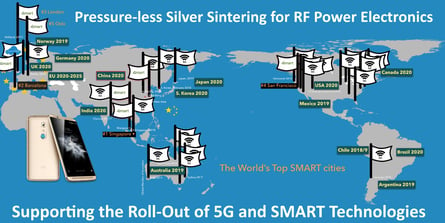Silver sintering technology has been around since the 1980s, but the process has faced numerous problems. The limits of traditional sintering, rapidly growing market demand, 5G, evolving technologies, issues of energy and eco-sustainability, as well as lead-free requirements have led many (including Palomar Technologies) to revisit these challenges. It must be emphasized in our case, in the context of pressure-less applications for high temperature applications, such as those used for RF power electronics.
This blog sets the stage for a series on silver sintering jet dispensing technologies. Included in this first review will be an examination of the advantages of pressure-less sintering together with silver’s performance as a solder agent over and against the more traditional materials of gold and lead.
pressure-less sintering together with silver’s performance as a solder agent over and against the more traditional materials of gold and lead.
Silver vs. Lead and Gold
It has been amply demonstrated that Ag sintering material capability is beyond that of high-lead (Pb) in respect to:
- A processing temperature similar to, or even lower than, current high-Pb solders.
- Higher service temperature capabilities due to its high melting point 961°C.
- Higher value of thermal conductivity as compared to that of high-Pb solder.
- Superior mechanical and electrical properties, specifically other lead-free alternatives.
Gold has been the historically preferred alloy due to its extraordinary physical properties. Price, scalability, and sustainability rule it out for long-term industrial use, however.
Against this backdrop, pressure-less silver sintering offers a cost-effective yet comparably efficient bond as lead and gold, and does so over widespread applications that secure void-free, strong, superior thermal and electrical conductivity. Silver has the ability to decrease the junction temperature (Tj) of a device up to 100°C. In the process, when the silver material is heated under optimal circumstances, its form will change from powder to a solid structure. Compared to traditional solder material, the action of sintering results in a more reliable bond, significantly increasing performance and lifetime, while being more energy efficient and placing less stress on the package.
In addition, pressure-less sintering as a process offers a series of other significant advantages:
- It can be sintered in the presence of air.
- It can be dispensed using the same set of tools and with a similar procedure as solder paste; a straight forward “drop-in” solution.
- It does not require the special tooling to avoid damaging the die that is needed in pressured applications.
- It can be deployed with Nano-particles that increase the surface area coverage; smaller particles have more free energy and need less external energy to fuse.
- It allows for the coverage of larger surface area dies. Moreover, silver paste compounds optimize results with low porosity.
- It can match AuSi and AuSn in terms of thermal conductivity.
In the next blog, we will set out to detail the background and justification behind the development work we undertook at our newly upgraded Innovation Center in Singapore, applying silver sintering on a series of test dies using a Palomar 3880 Die Bonder, retro-fitted with a Musashi high speed jetting dispenser. In particular, we will note that the jet dispense, though being a powerful and versatile tool, proved insufficient on its own to achieve a fixed height bond line with consistent low void results. Only when we developed a proprietary “Fixed BLT” software were a number of underlying problems solved. The final product consistently delivered exacting bond line specs with excellent planarity and a virtually void-free bond in a time-effective, commercially viable fashion.
To learn more about pressure-less silver sintering for RF Power Electronics, download our technical article: Energy and Eco-Sustainability using Pressure-less Silver Sintering for RF Power Electronics.